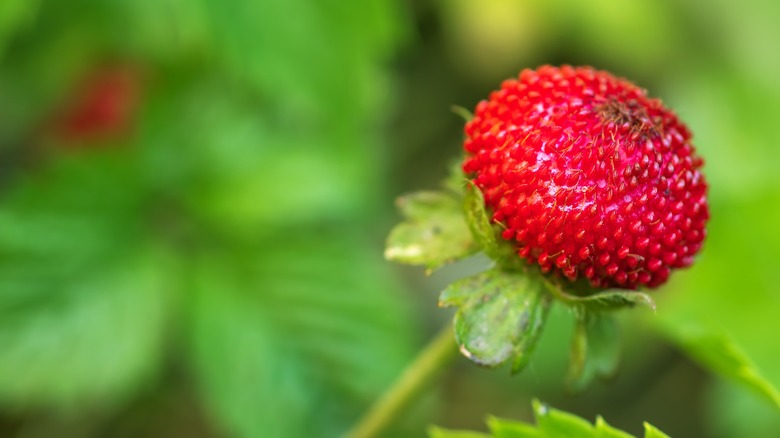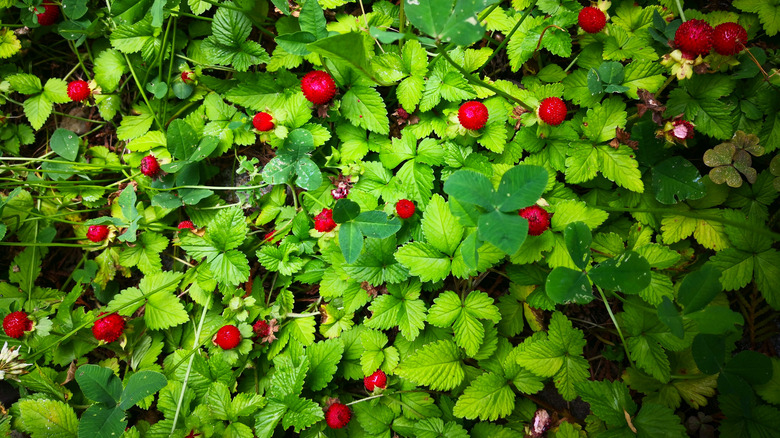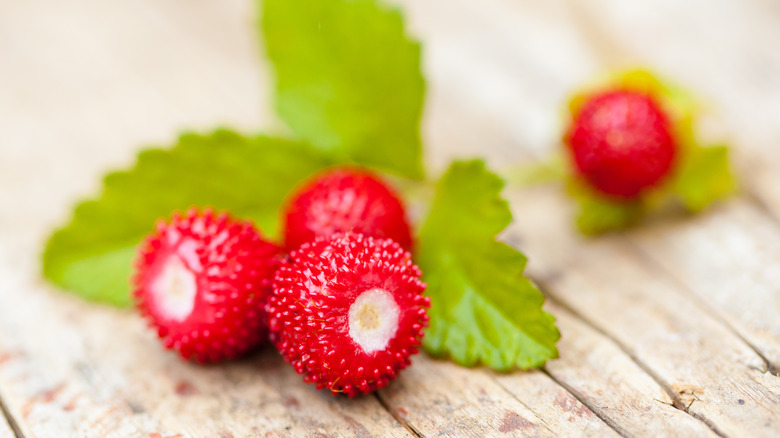How To Spot Mock Strawberries And What To Do With Them
If you spot a plant with small, bumpy red fruits in your backyard, it could be a strawberry plant or it could be a poser. Mock strawberries, known by their scientific name potentilla indica, are very similar in appearance to wild strawberries, but if you were to bite into one, you'd immediately be able to tell it's not the real thing. While the fruits we typically buy and eat are part of the Rosaceae plant family along with mock strawberries, they differ in quite a few key ways.
For one, the mock versions are native to Asia and are also called Indian, Gurbir, or False strawberries. On the other hand, the fruits we get at the grocery store are typically native to North America and produced mostly in California, although some varieties of strawberries are also grown in Central and South America. Perhaps most importantly, while we cultivate and enjoy eating ripe, juicy real strawberries, the mock ones are typically known as a weed. In fact, some organizations, like The Minnesota Department of Natural Resources, advise reporting sightings of mock strawberry plants since they're considered an invasive species.
How to spot mock strawberries
At first glance, it may be tough to tell the difference between mock strawberries and real ones. But if you take a closer look and know what to check for, you should be able to decipher between the two pretty easily. An instant clue can be found in the plant's flowers — real strawberry plants will have white or pink ones, while mock strawberry plants will have yellow flowers with five petals. And although the red fruits look pretty similar to the real thing, mock strawberries are typically a little smaller with more distinguished bumps. Crucially, the fake fruits grow upward, making them much more visible amongst their green leaves. On the flip side, real strawberries grow downward.
If you're still stumped, you can also try looking at the leaves shape and size. Mock strawberry plants have smaller leaves that show up in sets of three and are hairless, dark green, and coarse. But the biggest tell of all may come from actually biting into one of the fruits. It's completely safe to eat mock strawberries — however, you may not want to. Compared to the sweet, juicy flavor of a real one, the fake versions are bland, dry, and practically tasteless.
What to do with mock strawberries
Although mock strawberries don't have much of a taste, people occasionally use them for food or drinks, and some even say they have a slight watermelon taste. Since they're completely edible, you can make a mild juice or jam out of them, or even use them to stretch out jams made out of more strongly-flavored fruits. Although they may not be as nutritious as real strawberries, they still hold some value. Dave's Garden notes that 100 milliliters of mock strawberry juice have about six milligrams of Vitamin C. The plant's leaves can also be added to salads, cooked as part of a veggie dish, or brewed to make tea. They've also been used as herbal medicine to help treat snake bites, insect bites, eczema, and boils.
Perhaps more commonly, though, mock strawberry plants are treated as a weed. If you have no interest in eating the fruits or using the leaves, you may want to take measures to control their growth. Since these weeds can take over your other plants, it's a strategic move to weed them by hand or with mulch. Some states, like Minnesota, may even want you to report them.


